
Few musicals lend themselves to as many different interpretations as the Stephen Schwartz classic Pippin. Reprise did it sexy and Chicago-esque some years back; East West Players took an Asian hip-hop approach to the material; Deaf West at the Taper featured not one but two Pippins, one deaf and one hearing; and the recently reviewed Simi Valley Cultural Arts Center revival set Pippin in the world of “Steampunk Carnivale.”
Now, Scenie-winning San Diego Director Of The Year James Vasquez puts his own personal stamp on Pippin for San Diego’s LGBT Diversionary Theater, and trust me, you may have seen Pippin before, even many times before, but you’ve never seen a Pippin like this one.
 But first a bit of background to set the stage.
But first a bit of background to set the stage.
Musical theater aficionados know Pippin as the nearly 2000-performance 1972 Broadway smash that introduced Stephen Schwartz to the world. Songs like “Magic To Do,” “Corner Of The Sky,” “Morning Glow,” and “I Guess I’ll Miss The Man” have entered the pop/Broadway music lexicon even as its title character’s quest to be “Extraordinary” (“When you’re extraordinary, you gotta do extraordinary things”) has taken him, and four decades of audiences, on an extraordinary journey indeed.
Suggested by the life of the eldest son of 8th Century Emperor Charlemagne, Pippin (book by Roger Hirson) opens with yet another of the monarch’s homecomings from battle. Young Pippin, longing to prove himself to his father, convinces Charlemagne to let him join in the fight against the hated Visigoths, though it doesn’t take long for our young hero to discover the truth of the proverbial “War is not the answer,” and he soon retreats to the countryside. There, on his grandmother Berthe’s estate, Pippin tries on for size the “Simple Joys” of rustic living—and finds them lacking as well. Sex is the next stop on Pippin’s quest, followed by an attempt to revolutionize society, even if it means bumping off Dad to do it. Despite all these attempts, Pippin still finds his life as unfulfilled and unfulfilling as ever even as Act One draws to a close. Fortunately, Pippin The Musical still has another act up its sleeve.
To tell this story, Schwartz and Hirson took a surreal route that was hardly par for the course on Broadway in the early 1970s, an approach that featured a pizzazzy “Leading Player” as our narrator-guide and spotlighted director-choreographer Bob Fosse’s signature turned-in knees, jutting hips, sideways shuffling, and hand-and-shoulder rolls, moves you’d hardly expect from a musical set in medieval times.
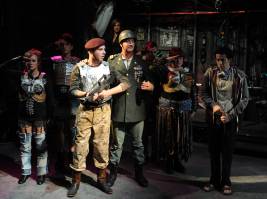 Vasquez and an exceptional design team have situated Schwartz’s 8th Century tale in what appears to be a post-apocalyptic Blade Runneresque world, scenic designer Sean Fanning’s extraordinary set suggesting an underground bunker whose walls have been plastered with paraphernalia of our civilization—a profusion of CDs and shoes and beer bottles and hair dryers and cassette cases and prescription bottles and assorted other relics. Music director Charlie Reuter and an awesome onstage band give this Pippin a hard rock sound, electric guitars predominating, an edginess echoed in Shirley Pierson’s astonishing costumes and Luke Olson’s stark, dramatic lighting design.
Vasquez and an exceptional design team have situated Schwartz’s 8th Century tale in what appears to be a post-apocalyptic Blade Runneresque world, scenic designer Sean Fanning’s extraordinary set suggesting an underground bunker whose walls have been plastered with paraphernalia of our civilization—a profusion of CDs and shoes and beer bottles and hair dryers and cassette cases and prescription bottles and assorted other relics. Music director Charlie Reuter and an awesome onstage band give this Pippin a hard rock sound, electric guitars predominating, an edginess echoed in Shirley Pierson’s astonishing costumes and Luke Olson’s stark, dramatic lighting design.
Pippin’s original cast of twenty has been sliced to its barest minimum, with eight of San Diego/Southern California’s most talented triple threats not only bringing all of the musical’s major characters to life, but assorted soldiers, nobles, peasants, and more.
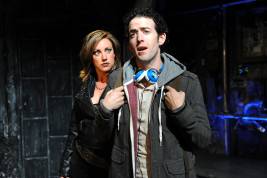 A sensational Louis Pardo takes the title character, a seeker of life’s meaning often cast as a white-bread boy-next-door type, and turns him into the kind of oddball outsider Pardo has brought to life in shows as diverse as Avenue Q, Spelling Bee, Altar Boyz, and Peter Pan. Vocally, you won’t find a stronger Pippin than Pardo, whose power pipes are both rock-concert-ready and as clear as crystal.
A sensational Louis Pardo takes the title character, a seeker of life’s meaning often cast as a white-bread boy-next-door type, and turns him into the kind of oddball outsider Pardo has brought to life in shows as diverse as Avenue Q, Spelling Bee, Altar Boyz, and Peter Pan. Vocally, you won’t find a stronger Pippin than Pardo, whose power pipes are both rock-concert-ready and as clear as crystal.
Supporting players are each and every one fabulous, from Andy Collins Pattonesque Charlemagne to Tony Houck’s lovable lummox of a Louis to Wendy Maples’ earth mother Berthe. An enchanting Megan Carmitchel gives Catherine just enough of an bite to fit Vasquez’s vision to perfection, while teenaged Hunter Schwarz, fresh from Diversionary’s Altar Boyz, plays Theo with edgy, boyish spunk (and makes an age-appropriate exit during the production’s sex-drugs-and-rock-and-roll orgy set here in a racy strip club).
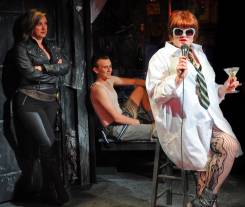 Vasquez bends genders to dazzling effect in Pippin’s two remaining characters, beginning with The Leading Player, a role originated on Broadway by showman extraordinaire Ben Vareen. At Diversionary, a terrific Courtney Courey gives this leather-clad female Leading Player a sly observer’s eye and razor-sharp vocals as she comments on and occasionally participates in Pippin’s life.
Vasquez bends genders to dazzling effect in Pippin’s two remaining characters, beginning with The Leading Player, a role originated on Broadway by showman extraordinaire Ben Vareen. At Diversionary, a terrific Courtney Courey gives this leather-clad female Leading Player a sly observer’s eye and razor-sharp vocals as she comments on and occasionally participates in Pippin’s life.
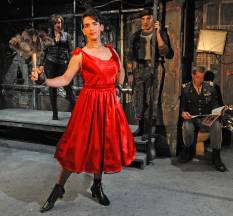 As for Pippin’s stepmother Fastrada, a role that has been portrayed by women as gifted and diverse as Chita Rivera, Leland Palmer, Priscilla Lopez, Sara Gettelfinger, and Luba Mason, a stunning Luke Jacobs not only looks gorgeous and glamorous à la Joan Crawford/Loretta Young in his scarlet 1950s gown, but plays the sexy MILF with oodles of vamp appeal. As for Louis’s incestuous relationship with his mommy, well that takes on whole new same-sexual connotations with Jacobs in the role, and never more than when mom and son share a long, sensuous lip lock.
As for Pippin’s stepmother Fastrada, a role that has been portrayed by women as gifted and diverse as Chita Rivera, Leland Palmer, Priscilla Lopez, Sara Gettelfinger, and Luba Mason, a stunning Luke Jacobs not only looks gorgeous and glamorous à la Joan Crawford/Loretta Young in his scarlet 1950s gown, but plays the sexy MILF with oodles of vamp appeal. As for Louis’s incestuous relationship with his mommy, well that takes on whole new same-sexual connotations with Jacobs in the role, and never more than when mom and son share a long, sensuous lip lock.
Vocally, this is as strong a cast as you’re ever likely to see, and they are eight snappy dancers to boot, Vasquez assisted by Annette Ye for the show’s striking choreography.
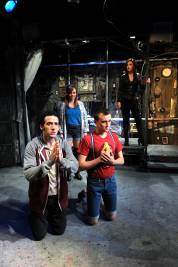 Design highlights include the blank white passageway from which Pippin (and other characters) enter and depart; a vast variety of props (courtesy of properties designer David Medina) including Louis’s play machine gun, a talking hand puppet of a dead Visigoth’s skull, and the Obamafied image of PIPPIN 2012 campaign posters; and costumes featuring plenty of fishnets and distressed, torn, cut-off denim and camouflage prints alongside Charlemagne’s WWII officer’s uniform and helmet, Berthe’s oversized men’s dress shirt and tie worn over fishnet stockings, and Catherine’s twin-cone bra. Kevin Anthenill’s electrifying sound and video design features a huge potpourri of images projected on multiple monitors, animated hearts for Pippin’s and Catherine’s “Love Song,” and even a toilet flush or two.
Design highlights include the blank white passageway from which Pippin (and other characters) enter and depart; a vast variety of props (courtesy of properties designer David Medina) including Louis’s play machine gun, a talking hand puppet of a dead Visigoth’s skull, and the Obamafied image of PIPPIN 2012 campaign posters; and costumes featuring plenty of fishnets and distressed, torn, cut-off denim and camouflage prints alongside Charlemagne’s WWII officer’s uniform and helmet, Berthe’s oversized men’s dress shirt and tie worn over fishnet stockings, and Catherine’s twin-cone bra. Kevin Anthenill’s electrifying sound and video design features a huge potpourri of images projected on multiple monitors, animated hearts for Pippin’s and Catherine’s “Love Song,” and even a toilet flush or two.
Also receiving design credit are Chandra Anthenill (scenic painting), Shirley Pierson (costume technician), and Chris Renda, Chris Rynne, and Jeffrey Arneson (lighting consultants). Pippin is produced by Bret Young.
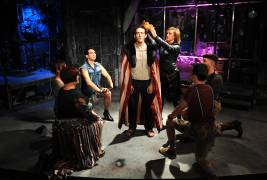 Performing alongside Reuter on piano are Andrew Michel on guitar, Charlie Weller on drums, and (at some performances) Lyndon Pugeda on piano and Adam Michel on guitar.
Performing alongside Reuter on piano are Andrew Michel on guitar, Charlie Weller on drums, and (at some performances) Lyndon Pugeda on piano and Adam Michel on guitar.
Chandra and Amy Anthenill are (respectively) stage manager and assistant stage manager.
Pippin’s message can sometimes get lost in big stage productions amidst flashy, large-cast productions numbers. Such is fortunately not the case in Diversionary’s leaner but hardly bare-bones production. For those who may not have seen Pippin before, this is an exciting and absolutely unique introduction to the Stephen Schwartz classic. For theatergoers like this one who’ve seen Pippin a half-dozen or more times before, this is a revival unlike any other, and one that is not to be missed.
Diversionary Theatre, 4545 Park Boulevard, San Diego.
www.diversionary.org
–Steven Stanley
September 15, 2012
Photos: Ken Jacques


 Since 2007, Steven Stanley's StageSceneLA.com has spotlighted the best in Southern California theater via reviews, interviews, and its annual StageSceneLA Scenies.
Since 2007, Steven Stanley's StageSceneLA.com has spotlighted the best in Southern California theater via reviews, interviews, and its annual StageSceneLA Scenies.







 COPYRIGHT 2025 STEVEN STANLEY :: DESIGN BY
COPYRIGHT 2025 STEVEN STANLEY :: DESIGN BY